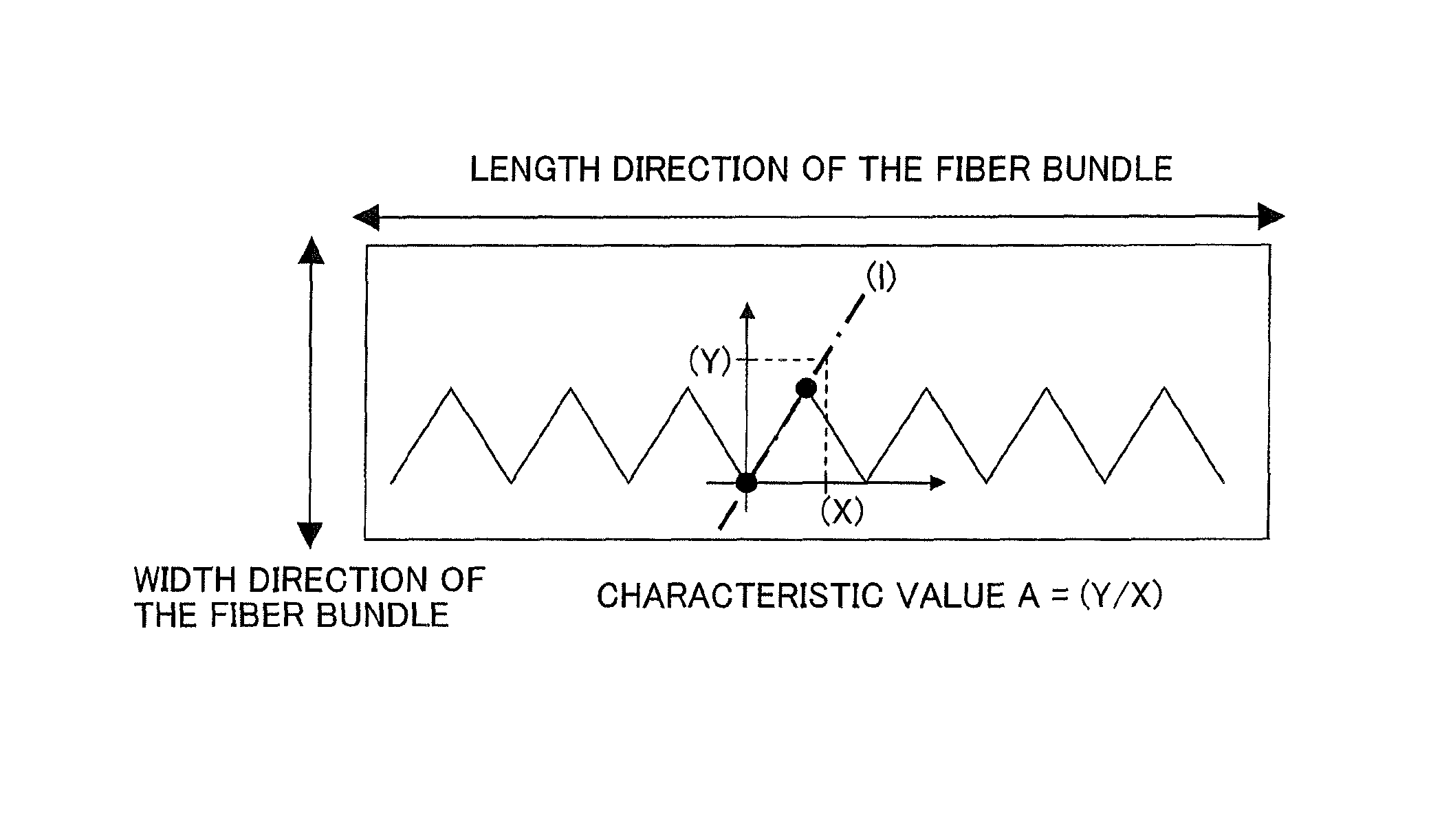Fiber bundle
a fiber bundle and fiber technology, applied in the field of fiber bundles, to achieve the effects of excellent handling, excellent packing and handling behavior, and stable and excellent spreading behavior
- Summary
- Abstract
- Description
- Claims
- Application Information
AI Technical Summary
Benefits of technology
Problems solved by technology
Method used
Image
Examples
example 1
[0067]An undrawn 10.8 dtex filament was obtained by conjugate melt-spinning high density polyethylene and polyethylene terephthalate at a mass ratio of 50:50 using a sheath-core nozzle. These undrawn 31,000 filaments were bundled and this was drawn by 3.6 of drawing ratio with a hot-roll drawing machine heated to 90° C. followed by the introduction of crimps at 15.3 peaks / 2.54 cm using a 20 mm-wide crimper that had the ability to apply stress from the width direction that made possible a content of 35% or more of crimps having peaks / valleys in the width direction. A dry heat treatment at 110° C. was then carried out to obtain a fiber bundle with a single filament fineness of 3.5 dtex and a total fineness of 107,000 dtex.
[0068]The crimps in this fiber bundle formed peaks / valleys mainly in the width direction of the fiber bundle; the characteristic value A was 1.99; and the bundlability and pull up behavior were both excellent. When this was spread by 1.4 of drawing ratio at 25 m / min,...
example 2
[0069]An undrawn 10.8 dtex filament was obtained by conjugate melt-spinning high density polyethylene and polypropylene at a mass ratio of 50:50 using a sheath-core nozzle. These undrawn 24,000 filaments were bundled and this was drawn by 4.0 of drawing ratio with a hot-roll drawing machine heated to 90° C. followed by the introduction of crimps at 15.3 peaks / 2.54 cm using the same crimper as in Example 1. A dry heat treatment at 110° C. was then carried out to obtain a fiber bundle with a single filament fineness of 2.8 dtex and a total fineness of 70,000 dtex.
[0070]The crimps in this fiber bundle formed peaks / valleys in the width direction of the fiber bundle and in the thickness direction of the fiber bundle; the characteristic value A was 1.61; and the bundlability and pull up behavior were both excellent. When this was spread 1.4× at 25 m / min, the continuous fibers were uniformly spread in the width direction; unspread fiber bundle was also not present; and a web with an excell...
example 3
[0071]An undrawn 10.8 dtex filament was obtained by conjugate melt-spinning high density polyethylene and polyethylene terephthalate at a mass ratio of 50:50 using a sheath-core nozzle. These undrawn 25,000 filaments were bundled and this was drawn by 3.6 of drawing ratio with a hot-roll drawing machine heated to 90° C. followed by the introduction of crimps at 15.3 peaks / 2.54 cm using the same crimper as in Example 1. A dry heat treatment at 110° C. was then carried out to obtain a fiber bundle with a single filament fineness of 3.6 dtex and a total fineness of 89,000 dtex.
[0072]The crimps in this fiber bundle formed peaks / valleys mainly in the width direction of the fiber bundle; the characteristic value A was 2.17; and the bundlability and pull up behavior were both excellent. When this was spread by 1.4 of drawing ratio at 25 m / min, the continuous fibers were uniformly spread in the width direction; unspread fiber bundle was also not present; and a web with an excellent handle w...
PUM
| Property | Measurement | Unit |
|---|---|---|
| velocity | aaaaa | aaaaa |
| melting points | aaaaa | aaaaa |
| temperature | aaaaa | aaaaa |
Abstract
Description
Claims
Application Information
 Login to View More
Login to View More - R&D
- Intellectual Property
- Life Sciences
- Materials
- Tech Scout
- Unparalleled Data Quality
- Higher Quality Content
- 60% Fewer Hallucinations
Browse by: Latest US Patents, China's latest patents, Technical Efficacy Thesaurus, Application Domain, Technology Topic, Popular Technical Reports.
© 2025 PatSnap. All rights reserved.Legal|Privacy policy|Modern Slavery Act Transparency Statement|Sitemap|About US| Contact US: help@patsnap.com


